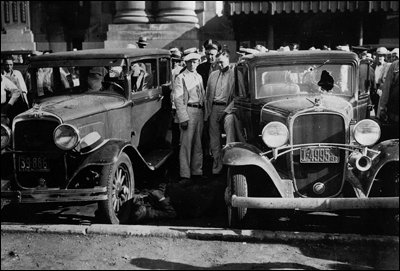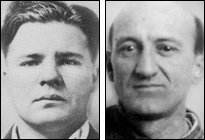Headline Archives |
|||||||||
| FBI 100 The Kansas City Massacre |
|||||||||
| 06/17/08 | |||||||||
|
The scene in front of the Kansas City railroad depot moments after the attack. The sun rose on June 17, 1933—75 years ago Tuesday—just like any other spring day in America’s heartland. But outside a massive train station in Kansas City, Missouri, a grand tragedy was about to unfold. Shortly after 7 a.m., a sudden burst of gunfire erupted outside the east entrance of Union Station. Its target was a troupe of lawmen who had just loaded escaped bank robber Frank “Jelly” Nash into a two-door Chevrolet, preparing to return him to nearby Leavenworth prison. Within seconds, two Kansas City police officers, an Oklahoma police chief named Otto Reed, and Bureau Special Agent Ray Caffrey had been murdered—along with Nash himself. Another two agents inside the car survived by slumping forward and pretending to be dead. Kansas City Special Agent in Charge Reed Vetterli, who had been standing near the front of the car, miraculously escaped with only a flesh wound. An officer who responded from inside the station fired at the escaping killers, but they got away. This brazen slaughter by submachine gun came to be called “The Kansas City Massacre,” and it turned into one of the early Bureau’s most important investigations, leading to a massive manhunt for the culprits and ultimately helping the agency gain new law enforcement powers. Who did it and why? That’s what we aimed to find out. It was tough going in the early days, with few solid leads and the recollections of surviving lawmen and witnesses less than clear. Ultimately, the evidence pointed to a bank robber and underworld assassin named Verne Miller as the leader of the plot. Miller was a good friend of Nash, and Nash’s wife had contacted the gunman to help spring her husband after he was arrested the day before the massacre. Miller raced to Kansas City, but he realized he needed help to free his friend. There, he was apparently introduced to Charles “Pretty Boy” Floyd, a notorious bank robber on the run, and his confederate Adam Richetti. It was these three men, we concluded, who had carried out the crime. The first priority was to find Miller. In October, agents traced him to the apartment of his girlfriend Vivian Mathias in Chicago. Miller escaped, but Mathias was captured and later pled guilty to harboring the fugitive. A month later, on November 29, the search came to an end when Miller turned up dead in a ditch near Detroit, Michigan, a victim of a dispute with the New Jersey underworld.
We then turned our full attention to finding Floyd and Richetti. The two men, we learned, had been traveling with a pair of women. On October 20, 1934, the four were driving in Ohio when Floyd crashed into a telephone pole. While the women took the car into the nearby town of Wellsville for repairs, Richetti and Floyd were spotted by local police and ended up in a firefight. Richetti was quickly captured, but Floyd got away. Two days later, Bureau agents and local authorities tracked Floyd to a farm near Clarkson, Ohio, where he was shot and killed. The Kansas City Massacre was a dark chapter for law enforcement and for the FBI in particular—at that time, one of the deadliest attacks on the law the nation had ever seen. Within a year of the tragedy, Congress responded by giving us new tools to fight crime—including statutory authority to carry guns and make arrests, both of which have been pillars in our work to protect the nation ever since. To learn more about the investigation, see our Famous Cases write-up. Also visit our Freedom of Information Act website to read our historic files on the investigation, which we are releasing for the first time online.
FBI 100 Series:
- Part 1: An Odd Couple of Crime - Part 2: First Strike: Global Terror in America - Part 3: The Lindbergh Kidnapping - Part 4: The Unabomber - Part 5: Bonnie and Clyde - More History stories |
 |
 |
 |
|
|

